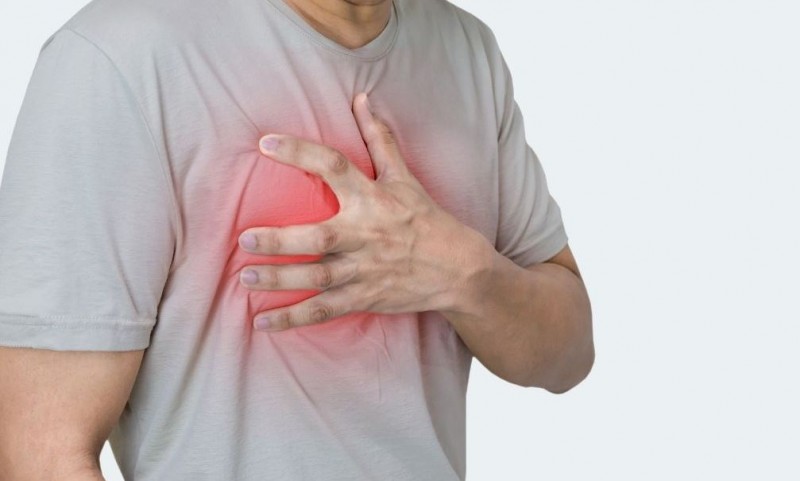
Heart attacks, also known as myocardial infarctions, are serious medical emergencies that require immediate attention. One of the most common misconceptions surrounding heart attacks is that they always present with left-sided chest pain. While this symptom is indeed prevalent, it is vital to recognize that heart attack symptoms can manifest in various ways and may not always be confined to the left side of the chest. This article aims to shed light on the diverse symptoms of heart attacks, their potential locations, and the dangers of misinterpreting them as benign issues like gas or acid reflux.
Diverse Manifestations of Heart Attack Symptoms
Contrary to popular belief, a heart attack's symptoms can extend far beyond the classic left-sided chest pain. While this pain might be sharp, crushing, or radiating, it is crucial to acknowledge that the pain's location can vary and might include the middle of the chest, the right side, or even areas seemingly unrelated to the heart. Recognizing these diverse manifestations is essential for early intervention and timely medical treatment.
Locations of Heart Attack Symptoms
Left-Side Chest Pain: The most commonly known symptom of a heart attack is left-sided chest pain. This discomfort is often described as a heavy, squeezing sensation that might radiate to the left arm, jaw, or shoulder. This classic symptom is a result of reduced blood flow to the heart muscle due to a blocked coronary artery.
Central Chest Pain: Heart attack symptoms can also present as pain or discomfort in the middle of the chest. This sensation might be mistaken for indigestion or gas, leading individuals to delay seeking medical help. Central chest pain should never be underestimated, as it could indicate a serious cardiac event.
Right-Side Chest Pain: While less common, heart attack symptoms can manifest on the right side of the chest as well. This type of pain might be mistaken for other conditions such as muscle strain or gallbladder issues. Ignoring right-sided chest pain can be perilous, as prompt treatment is crucial for minimizing damage to the heart muscle.
Radiating Pain: The pain associated with a heart attack can radiate to unexpected areas, such as the arms, neck, jaw, and shoulders. This phenomenon is often described as a discomfort that travels from the chest to these regions. Recognizing this radiating pain is imperative for understanding its cardiac origin.
Symptoms Beyond Chest Pain
Heart attack symptoms go beyond chest pain, and it's important to be aware of these other signs, as they can occur without chest discomfort. These symptoms might include:
Shortness of Breath: Unexplained shortness of breath, often occurring even at rest, can be an indication of a heart attack. This symptom arises due to the heart's compromised ability to pump blood effectively.
Nausea and Vomiting: Feeling nauseated or vomiting can be associated with a heart attack, particularly in women. These symptoms are often overlooked, attributed to digestive problems, and consequently, vital time for medical intervention can be lost.
Cold Sweats: Profuse and sudden cold sweats, not attributed to any physical activity or external temperature changes, can be a sign of a heart attack. This occurs due to the body's response to the stress of cardiac distress.
Fatigue: Unexplained fatigue, weakness, and lightheadedness can be indicative of a heart attack. These symptoms arise because the heart's compromised function affects the body's overall energy supply.
Misinterpretation and the Dangers
Misinterpreting heart attack symptoms as mere indigestion, gas, or acid reflux is a common yet dangerous misconception. Ignoring these symptoms or attributing them to benign causes can lead to delayed medical attention, resulting in irreversible damage to the heart muscle or even death. It is essential to understand that heart attack symptoms can mimic various conditions and should never be dismissed without proper medical assessment.
The Role of Gender and Age
Heart attack symptoms can also differ based on gender and age. Women are more likely to experience atypical symptoms such as shortness of breath, nausea, and back pain, in addition to chest discomfort. These differences can lead to underdiagnosis and delayed treatment, emphasizing the importance of recognizing a broader range of symptoms.
Similarly, age plays a role in the manifestation of heart attack symptoms. Elderly individuals might have fewer noticeable symptoms or might experience confusion, dizziness, or fainting, making diagnosis more challenging. Being attentive to subtle changes in health is crucial, especially for those at higher risk due to age.
Recognizing the various ways in which heart attack symptoms can manifest is essential for prompt and effective medical intervention. While left-sided chest pain is a well-known indicator, it is vital to remember that symptoms can present in the middle of the chest, on the right side, and even radiate to seemingly unrelated areas. The misconception of attributing heart attack symptoms to gas or acid reflux can have dire consequences, as delayed treatment can lead to permanent heart damage or fatal outcomes. Understanding the diverse symptoms of heart attacks and seeking medical attention without delay is paramount for safeguarding one's health and well-being.
Global Summit on Traditional Drugs: Bridging Ancient and Modern Practices, says Mandaviya
Embrace Besan: 5 Creative Ways to Boost Your Diabetes Diet
Is Chicken Good For Diabetics? Exploring the Diabetes-Friendly Benefits of Chicken Consumption